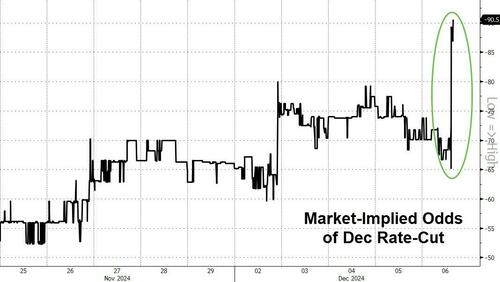"The Market Is Pricing A December Cut": Wall Street Reacts To Today's Solid Jobs Report
After today's solid jobs report, which showed hotter than expected payrolls and wage growth, and which hints at much more wage growth now that "foreign born" (i.e., illegal workers) are tumbling forcing employers to hire much higher paid domestic laborers, the market is still convinced that the Fed still remains on track to cut rates in two weeks, even though core CPI is once again on the rise, at 3.3% and soon much higher, while the Atlanta Fed's GDPNow tracker has the US economy growing also 3.3% this quarter.
Do Wall Street pundits agree? Below we have compiled a snapshot of some f the kneejerk reactions by traders, analysts and strategists.
Seema Shah, chief global strategist, Principal Asset Management:
"There are cracks in the labor market that require Fed attention. At the same time, with average earnings growth still stubborn, the Fed has to proceed down its rates path with significant caution and care. A December cut is in the offing but, come early 2025, the Fed is likely to slow its cutting pace to every other meeting. What started out as a Fed pivot has evolved into a central bank swerve."
Anna Wong, head of Bloomberg Economics:
“Job growth was brisk in November, as hiring activity rebounded from an October print weakened by hurricanes and strikes -- but the rebound is short of what it should have been if October’s weakness were all due to such temporary factors. For example, manufacturing job growth would still be in negative territory if not for a one-off boost from the resolution of the Boeing strike in early November. Indeed, the uptick in the unemployment rate – just 0.004 percentage point shy of rounding up to 4.3% — supports our contention that cyclical sectors are showing underlying weakness. Once all revisions to the data are in, we think they’ll show the true underlying pace of monthly job creation currently is barely positive — and well below what’s needed to stabilize the unemployment rate. That means the jobless rate will likely continue to climb. The November jobs report doesn’t seal the deal for a rate cut in December, but it also doesn’t take it off the table. We think the November CPI report (due out Dec. 11) will be critical for the Fed’s decision this month.”
Mike Zigmont, head of trading and research at Harvest Volatility Management:
“Small caps have underperformed for a long time until recently. My guess is that investors view today’s NFP as bullish and they are buying the small caps more than large because they think the outperformance will continue. If economy stays healthy and rates come down a little....it’s probably better for small caps.”
Carl Weinberg, High Frequency Economics:
"With earnings rising 4% at a year-on-year pace, there’s plenty of income to keep powering consumer spending. So retail sales should be good. Brisk consumer spending is what is making the economy grow so fast right now.”
Brian Coulton, chief economist at Fitch Ratings:
“The underlying growth in labor demand remains solid despite the small uptick in the unemployment rate – payrolls have grown by 172,000 per month over the last three months, probably closer to 200,000 if we allow for the October distortions. At the same time wage growth looks to have bottomed out at 4% in year-on-year terms and has crept up to 4.4% on a three-month annualized basis. That won’t stop the Fed from cutting rates again later this month but it will give them pause for thought – 4.4% wage growth doesn’t really work with 2% price inflation.”
Ira Jersey, Bloomberg Intelligence:
"Overall, the data isn’t quite strong enough to shift the odds of a December rate move by the Fed, and the Treasury yield knee-jerk rally reflects the market fearing even a better payrolls report,” BI’s Jersey says. The slightly higher unemployment rate will give the Fed comfort. Yet on this trend, we suspect a December cut may be followed by a January pause.... The market is basically pricing for a December cut, but then the Fed to skip January, cut in March and skip May, with a final cut in either June or July. Given the incoming economic data, we don’t think this is unrealistic at this point -- but we must remember this is a major shift from the cut at every 2025 meeting that was priced just three months ago."
Tom Porcelli, PGIM:
“There are some cracks in the labor backdrop but the floor’s not falling out from beneath us here.”
Mohamed El-Erian:
“The fact that the unemployment rate went back up means that the Fed will be comfortable cutting by 25 basis points and that the market will increase the probability of this happening. On the policy front, this did not complicate what would have been a messy situation.”
Source: Bloomberg



